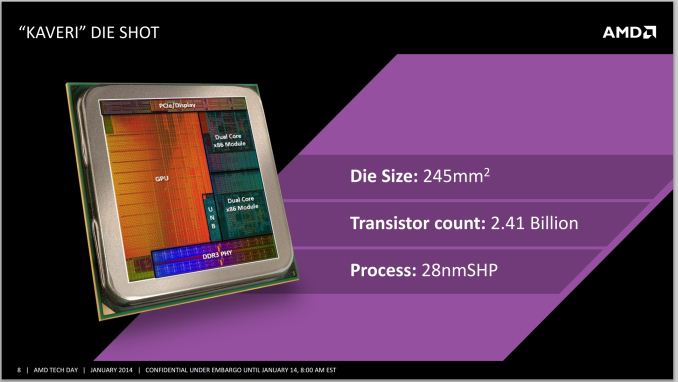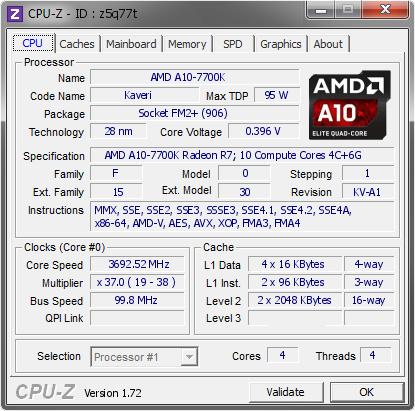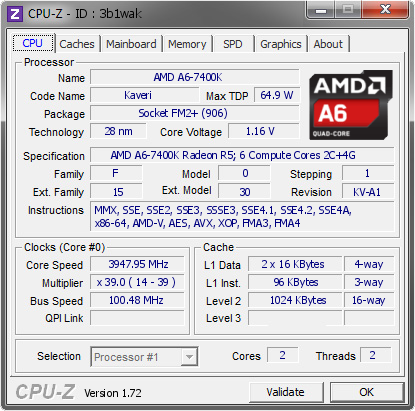The AMD A10-7700K and AMD A6-7400K CPU Mini-Review
by Ian Cutress on May 27, 2015 9:00 AM ESTAMD A10-7700K and AMD A6-7400K Conclusion
I started this mini-review stating that the question of the number of processors that both Intel and AMD produce all seem to differ by 100 MHz and $7, and that I had received questions as to why this is the case. Ultimately a lot of recommendations for computer components start to revolve around ‘Well for $10 more, you could get this’, and at some point you are considering something that costs $50 more. There has to be a point where you stop, especially if an IT department or system builder wants to go through and develop 200+ machines in a month.
Intel and AMD currently have different approaches to this. Intel likes to launch a big part of its stack all at once. Sometimes it will launch individual units outside this, or it will start a new line-up with one or two units then introduce the bulk later. With Haswell for example, on the socketed CPU space, we have 50 different CPUs varying in price, power, frequency, core count, threading and integrated graphics. Imagine the poor reviewer that has to test them all (insert here that I’d love to test them to get all the data, if I had time and could source them)!
AMD’s approach to Kaveri is to dribble rather than gush. Rather than overload the user base (both end-users and commercial) with a large haystack of parts, they launched two or three SKUs on day one, then one or two every 6-12 weeks since. This has some benefits, namely the improvement of the production process over time, the repeated opportunities to market new products and the opportunity to re-educate potential clients through the media. The downside of this strategy is one similar to starting with Swiss cheese and then filling in the holes – if a client wants a SKU with particular characteristics but the company does not have it, then they will go look for something else and take their money with them. It’s a method that acts as a double edged sword.
As AnandTech’s CPU editor, I get to play with a lot more SKUs than most. This means both the big shiny halo products, such as the 8-core goliaths, but also some of the higher volume dual core stuff which is more in line with a budget PC or mass PC build. With AMD’s strategy, as they have fewer processors overall, our coverage can be a little more complete than the others. AMD sampled us both the A10-7700K and the A6-7400K for this purpose, and we hope to work closely with them for future launches and get the best comparison list of their product stack.
Back to the SKUs tested for this mini-review, we can tell that the A10-7700K keeps up with the other A10 parts in our CPU testing, but as it has two fewer compute units in the integrated graphics it can lag behind a little and is more in line with the A8 processors in that regard, essentially making it more of a hybrid part. The A6-7400K fits into that budget CPU line at $64, and the results show this in both our CPU and GPU testing. The single module performs well enough in single threaded environments, but doesn’t have enough legs for the big tasks and can be swamped easily. Despite having two threads, the Bulldozer based design still has single-threaded like behavior in some tests. That being said, the graphics tests are a mixed bag. For titles that can use more threads, I can’t help but feel that it is a little held back, even at 256 SPs. For other titles, it performs on par with other processors almost double its price. Dual Graphics mode unfortunately was not possible with the A6, and it was also noticeable that some games (Shadows of Mordor in particular) took longer to load with only one module.
To say AMD’s APUs are like marmite (you either love them or hate them) is to gloss over a more complex issue. AMD’s design has its plus points and its negative points, a fact that AMD marketing knows when I speak to them. Nevertheless, they have to focus on the plus points, which include gaming at equivalent price points, DX12 support, OpenCL performance and moving forward with HSA. Using the right tool for the right job should now be considered a cliché, but it rings true when it comes to technology and more so than ever when innovative methods are continually being fashioned. Based on AMD’s Financial Analyst Day and their recent exposure into HBM (I highly suggest reading Ryan’s awesome writeup on it), I can safely say that I want to see an APU with HBM in the future. Despite the inevitability that AMD already know that people want one, I told them anyway. We will have to wait and see.














105 Comments
View All Comments
ToTTenTranz - Wednesday, May 27, 2015 - link
No.Vulkan is a fork of Mantle. Every single advantage of Mantle will be transposed for Vulkan.
DX12 is an API made largely to follow the steps of Mantle (lower CPU overhead).
Testing Mantle is the best way to predict how DX12 and Vulkan games will behave with slower CPUs.
The only thing that doesn't make sense is how Anandtech seems to be so "afraid" of showing how Bulldozer-derived CPUs work with Mantle.
DigitalFreak - Wednesday, May 27, 2015 - link
I'd rather see them spend time on more useful reviews of other products than on something few people care about. There are other sites where you can find that stuff.ToTTenTranz - Wednesday, May 27, 2015 - link
More useful than knowing if a $100 AMD CPU might be just as future-proof for DX12 games as a $300 Intel CPU?It seems to me that some companies could be VERY afraid of how useful for the consumer that might be, and how that would bring down the value (and margins) of pricier CPUs.
Not to mention the usefulness for TDP-constrained and lower-clocked mobile CPUs/APUs.
sonicmerlin - Wednesday, May 27, 2015 - link
Wouldn't almost everyone with an AMD CPU benefit from Mantle? And wouldn't Mantle performance reviews give a very accurate approximation of how their CPUs will perform under DX 12?eRacer1 - Wednesday, May 27, 2015 - link
Yep, need to get the word out not to bother buying AMD's Zen because even today's modest AMD APUs will be far more than enough to handle the multitudes of AAA Vulkan PC games launching throughout the next few years.Edens_Remorse - Wednesday, May 27, 2015 - link
That is completely untrue. Several new and upcoming games(BF Hardline, Star Citizen, Dragon Age Inquisition) utilize Mantle.Edens_Remorse - Wednesday, May 27, 2015 - link
Really suspicious that this "review" comes out a day before the new apu/athlon release. Intel's reign on gaming superiority is over as soon as devs stop being lazy(even with dx11 btw). Check out the new Witcher 3 fps comparisons (especially minimums) over at WCCFtech.der - Wednesday, May 27, 2015 - link
SO MINI ITS NICE!Crunchy005 - Wednesday, May 27, 2015 - link
I'm assuming the benchmarks were done at stock speeds. The 7700k seems to overclock nicely I would love to see OCed benchmarks.Teknobug - Wednesday, May 27, 2015 - link
I like the A8 7600, nice balance between performance and power efficiency but the i3 4130T beats it in some ways.